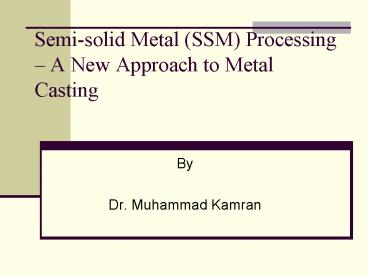Semisolid Metal SSM Processing A New Approach to Metal Casting - PowerPoint PPT Presentation
1 / 26
Title:
Semisolid Metal SSM Processing A New Approach to Metal Casting
Description:
During study of hot tearing of steel during solidification. Modeled by Sn-15Pb alloy using Coeutte Rheometer. Semi-solid Metal Processing ... – PowerPoint PPT presentation
Number of Views:3800
Avg rating:1.0/5.0
Title: Semisolid Metal SSM Processing A New Approach to Metal Casting
1
Semi-solid Metal (SSM) Processing A New
Approach to Metal Casting
- By
- Dr. Muhammad Kamran
2
Introduction
- Discovered at MIT
- in 1971
- During study of hot tearing of steel during
solidification - Modeled by Sn-15Pb alloy using Coeutte Rheometer
- Semi-solid Metal Processing
- Non-dendritic structure
- Solid-liquid region
- Suitable fraction solid
- Property exploited is
- Rheology
- Steady state rheology (Rheology)
- Transient state rheology (Pseudoplasticity)
- Time dependent rheology (Thixotropy)
3
Evolution to Non-dendritic Microstructure
- Under Forced Convection
- Fragmentation of primary dendrites by
- Root melting of secondary dendritic arms
- Bending and shearing of secondary denritic arms
- Bending and root melting of secondary arms
- Fragments of primary dendrites grow into globular
grains under forced convection
4
Evolution to Non-dendritic Microstructure
- Partial melting and Iso-thermal holding
- Low temperature eutectic phase melts in
semi-solid range - Highly stressed grain boundaries favours wetting
of grains with liquid - Grain become globular to reduce curvature and
liquid-solid interface energy
5
Introduction
- Characteristics of Slurry
- Sheared semi-solid slurry shows apparent
viscosity similar to machine oil - SSM Processing exploits
- Solidification mechanism in the solid-liquid
range i.e. nucleation and growth mechanisms
6
Alloy Characteristics
- Solidification range
- Low melting point phase/eutectic phase
- Temperature Sensitivity of solid fraction
- Castability
- Potential for aging etc.
7
Introduction
- Classification suggested by Flemings et.Al.
- Rheocasting
- Shearing the liquid while cooling from liquid to
liquid solid range and casting a net-shape
product - Thixocasting
- Shearing a partially melted suitable precursor in
semi-solid range - Compocasting
- Shearing a miscible or immiscible mixture of
composite in the solid-liquid range
8
Evolution to Non-dendritic Microstructure
- Other Mechanisms
- Grain refinement
- Spray forming and sintering
- Ultrasonic vibrations etc.
9
Processing Techniques
- Techniques for feed stock
- Techniques for Finished Product
10
Semi-solid Metal Processing Techniques
- Techniques for non-dendritic Feedstock
- Mechanical Stirring
- Megnatohydrodynamic (MHD) Stirring
- Stress Induced and melt Activated (SIMA) Process
- Spray Forming
- Liquidus Casting
- Ultrasonic treatment
- Grain refienment etc.
11
Semi-solid Metal Processing Techniques
- Mechanical Stirring
- Developed at MIT
- Stirring of liquid alloy while controlled cooling
in the semi-solid range using auger, impeller or
paddle - Batch type or continuous process
- For Rheocasting and Thixocasting
12
Semi-solid Metal Processing Techniques
- Magnetohydrodynamic (MHD) Stirring
- Patented by Alumax Inc.
- Vigorous stirring by rotating magnetic field
within the mould - Normally for producing feedstock for thixocasting
- Disintegrated fine dendrites which convert to
globular grains on partial melting - Most widely used process
13
Semi-solid Metal Processing Techniques
- Stress Induced and Melt Activated (SIMA) Process
- Severe deformation of precursor results in
residual stresses - On heating recrystallisation occurs
- On partial melting low melting point phase
becomes liquid - High residual stress favours wetting of grain
boundaries - Higher curvature and liquid-solid interface
energy favours globular grain morphology - Longer holding time favours coarsening and
agglomeration which deteriorate
semi-solidprocessability
14
Semi-solid Metal Processing Techniques
- Liquidus Casting
- Pouring of melt at near-liqudus temperature
- Higher rate of Nucleation favouring fine grain
size - On partial melting fine grains transform to
globular grains - Grain Refinement
- Promote heterogeneous nucleation
- Finer grain size
- Grains transform to globular on partial melting
15
Semi-solid Metal Processing Techniques
- Techniques for Net-shape Product
- Rheocasting
- Thixoforming
- Thixomoulding
- Rheomoulding etc.
16
Semi-solid Metal Processing Techniques
- Rheocasting
- Non-dendritic ally slurry obtained from shearing
while cooling from liquid state - Mechanical stirring
- MHD Stirring
- New Rheocasting (NRC)
17
Semi-solid Metal Processing Techniques
- Thixocasting
- Partial melting of suitable feedstock
- Mechanical stirring
- MHD stirring
- SIMA process
- Spray forming
- Thixocasting
- Thixoforging
18
Semi-solid Metal Processing Techniques
- Thixomoulding
- Simultaneous heating and shearing of solid
feedstock in a chamber by rotating barrel - Designed for Mg alloy
- Controlled atmosphere
- Similar to injection moulding
19
Semi-solid Metal Processing Techniques
- Rheomoulding
- Vigorous Shearing of liquid alloy using screw
type drive while cooling - Similar to Injection moulding
- Suitable even for immiscible alloy formation and
processing - Twin Screw Rheomoulding (TSRM) process is an
upgradation
20
Commercial features
- Advantages
- Energy efficient
- Production rate compete that for pressure die
casting - Smooth die filling with no air entrapment
favouring product soundness - Lower processing temperature
- Lower Impact to the die
- Reduced solidification shrinkage
21
Commercial features
- Disadvantages
- Relatively higher feedstock material cost
- Precise control of operating condition is
required. - Liquid segregation may occur as a result of
non-uniform heating
22
Commercial features
- Potential Applications
- Replacement of permanent mould parts to eliminate
machining and finishing - Pressure tight parts such as master brake
cylinders, fuel rails, air conditioner compressor
housing etc. - High strength parts such as engine mounts, tie
rods etc. - Wear resistant parts made from hypereutectic
alloys such as compressor piston, brake drums,
gear shift levers etc. - Forged parts requiring excessive tooling
23
Commercial features
- Current Applications/Products
Hydraulic Brake Valve
Automobile Wheels
Brake master Cylinder
24
Commercial features
Door Pillars for Audi
Control arms for Steering
Fiat Engine bracket
25
Future Developments
- Process development
- Mechanism of formation of non-dendritic structure
- Alloy development
- Simulation studies of process
- Viable process for steel and Cast Iron
26
- Thank You for Your Patience































